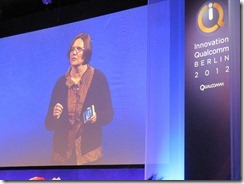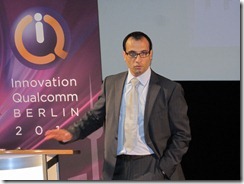Qualcomm’s IQ 2012 event for the EMEA region was held in Berlin in September, where the technology provider emphasised the central role it is playing in the creation and delivery of ever greater quantities of mobile digital content. Qualcomm chipsets have never been in higher demand as the smartphone frenzy shows no signs of dissipating across emerging as well as developed markets. Comm. reports from Berlin
Paul Jacobs, Qualcomm’s CEO, was not present at the EMEA’s IQ event 2012, instead taking part at the equivalent shows in Brazil and India
There is no denying the investment that Qualcomm has made over the decades in order to enjoy its position as the leading smartphone chipset provider, actively involved in shaping the direction of the mobile telecom sector. According to Steve Mollenkopf, Qualcomm’s chief operating officer, the company has invested US$21.2 billion cumulatively in R&D in the 27 years of its existence. The investment is clearly paying off with Qualcomm having shipped 483 million chipsets in the last year to September 2012.
Qualcomm’s latest series of multimedia chipsets, the Snapdragon S4 series, are all-in-one mobile processors containing four CPU cores each, and have been instrumental in supporting much of the multimedia capabilities of modern smartphones across manufacturers.
With 900 million 3G connections already found across emerging markets, and the US$320 billion global revenues from global mobile data revenues for the year to end-2011, the mobile data opportunity is larger than the revenues generated from the music industry, Hollywood movies, ISPs, and cable TV annually combined, Mollenkopf explained.
“There are 89 LTE networks worldwide today and we believe there is still a long runway for growth,” Mollenkopf said. “There are 472 HSPA networks worldwide, and Qualcomm is preparing for a 1000x growth in data traffic between 2011 and 2016,” he added.
Mollenkopf also expressed satisfaction with the developments occurring with Vuforia, Qualcomm’s augmented reality programme. The platform is reported to be enjoying tremendous growth with use in more than 1,000 applications in the last 12 months. With nearly 30,000 registered developers from more than 130 countries, the Vuforia platform continues to drive a new generation of mobile experiences that enhance the value of print media and advertising, consumer products and packaging, and educational materials.
The Vuforia platform adds value for consumer-facing companies by driving engagement across multiple customer touch points, including printed advertising, products and packaging, and in retail environments. Vuforia is enabling real-world interactivity for a growing number of leading brands, including: Anheuser-Busch, Audi, Johnson & Johnson, Lowe’s Canada, Maybelline, Nike, Sony Pictures Entertainment, Taco Bell and Virgin Media.
Mollenkopf said Vuforia, Qualcomm’s augmented reality platform, is enjoying tremendous growth with use in more than 1,000 applications in the last 12 months, and 30,000 registered developers
Mollenkopf also pointed out that more than 30 billion mobile applications were downloaded during 2011, with this number expected to grow to 66 billion by the end of 2016. And with more than five billion smartphones expected to be sold between 2012 and 2016, the opportunities for mobile network operators to monetise digital services going forward appear greater and greater.
Over 50 per cent of the projected total smartphone shipments in 2016 are expected to be to emerging markets, making handset manufacturers such as Nokia keen to maintain their strategic positioning both in the smartphone space as well as in developing markets.
“There is a shift from a battle of devices to a war of ecosystems,” said Jo Harlow, executive vice president of Smart Devices at Nokia. “18 months ago we instituted strategic changes and chose Microsoft as our platform/ecosystem partner with Windows Phone. In just six months we developed products on this platform.”
Windows Phone 8 was announced in June, and Harlow claims it offers the same experience on the mobile as one has become accustomed to on a desktop. Windows Phone products are currently sold in 54 countries, and Harlow forecasts that location and contextual services will be the future battle ground of the mobile application ecosystem.
“Last week we launched the Lumia 920, which is the flagship Windows Phone 8 smartphone, and which incorporates the latest advances in Nokia PureView imaging innovation,” Harlow said. “Using advanced floating lens technology, the camera in the Nokia Lumia 920 is able to take in five times more light than competing smartphones without using flash, making it possible to capture clear, bright pictures and video indoors and at night. It also compensates for hand movement while the photo is being taken.”
Over 100,000 apps have been developed for Windows Phone since Nokia began supporting the platform, with Harlow describing the handset manufacturer’s efforts as “looking to build the third ecosystem (as distinct from iOS and Android).”
Nokia’s Jo Harlow said over 100,000 apps have been developed for Windows Phone since Nokia began supporting the platform
Qualcomm also continues to assist network operators, particularly in emerging markets, to harness the power of smartphones. Last July the company launched its Qualcomm Powered smartphone initiative in Saudi Arabia, aimed at bringing OEMs (original equipment manufacturers), retailers, and network operators closer together to drive mobile digital services usage.
Speaking exclusively to Comm. at the time, Jay Srage, Qualcomm’s president for the MEA region said that the technology provider had partnered with Saudi telco Mobily; Saudi handset retailers Axiom and Jarir Bookstores; and six device manufacturers – Sony Ericsson, HTC, Alcatel, Samsung, Acer, and Huawei – in the offer of a joint strategic and marketing campaign aimed at driving up smartphone and data usage in the kingdom.
“Etisalat Misr launched a white label handset, and there are other such initiatives in South Africa and Nigeria,” Srage said at IQ 2012. “Our role in all this is to push data usage on mobiles and the Qualcomm Powered initiative is a joint marketing campaign to push smartphones in-market,” he added.
Murthy Renduchintala, Qualcomm Mobile & Computing’s (QMC) senior VP and co-president offered an insight into the type of traction Qualcomm has in mobile multimedia device space, with more than 50 manufacturers shipping with Qualcomm; 420+ devices announced incorporating Qualcomm chipsets; 400+ designs in development; and 30+ tablets powered by Qualcomm chipsets.
Jay Srage said Qualcomm continues to place significant emphasis on the development and growth of digital services on smartphones
Jens Schulte-Bockum, Vodafone Germany’s CEO sited his company’s deployment of LTE in 2010 as a reference point to other network operators moving in the same direction. In two years’ time the operator expects to enjoy full national coverage, with LTE having initially been utilised as a fixed-line broadband substitute. LTE and UMTS account for 90 per cent of households with broadband access in the Germany.
Vodafone’s LTE network extends to more than 50 per cent of Germany’s surface area, covering over 67 per cent of the county’s large cities. By March/April next year, the operator expects its LTE coverage to extend to the country’s largest 80 cities.
The on-going challenges being faced by network operators in the monetisation of digital services are aptly highlighted by Schulte-Bockum, who described how 15 per cent of a mobile data network’s capacity is utilised generating money through services such as email, while 85 per cent of capacity is utilised for video, which is not yet making money for operators. 
Jens Schulte-Bockum, CEO of Vodafone Germany, forecasts that by March/April next year, the operator expects to have its LTE coverage extend to the country’s largest
“Vodafone is evolving to become a connectivity and services enabler,” explained Schulte-Bockum. We have an overall subscriber base of 36 million in Germany and if we could convert half of that base to LTE in the next three years I would consider that successful,” he added.





0 comments ↓
There are no comments yet...Kick things off by filling out the form below.
Leave a Comment